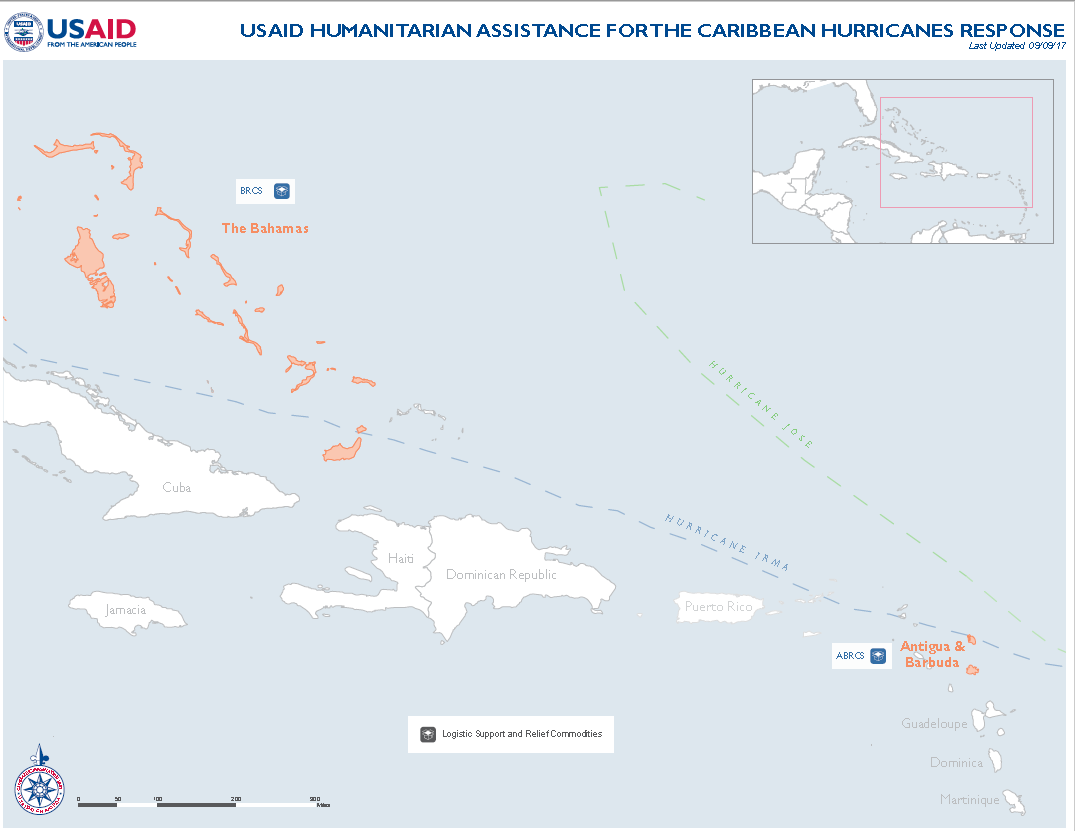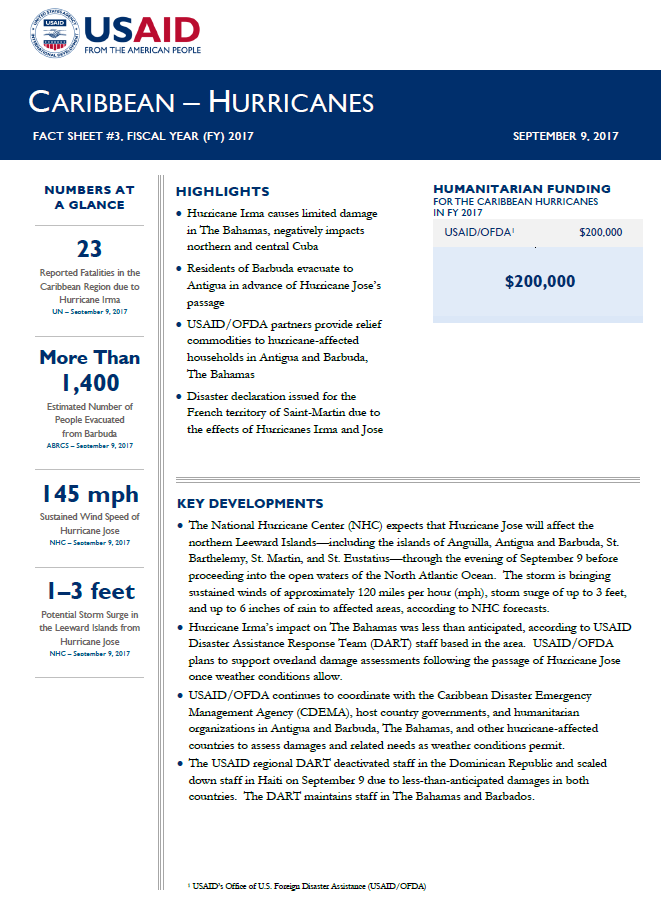September 09, 2017
Highlights
- Hurricane Irma causes limited damage in The Bahamas, negatively impacts northern and central Cuba.
- Residents of Barbuda evacuate to Antigua in advance of Hurricane Jose’s passage.
- USAID/OFDA partners provide relief commodities to hurricane-affected households in Antigua and Barbuda, The Bahamas.
- Disaster declaration issued for the French territory of Saint-Martin due to the effects of Hurricanes Irma and Jose.
Key Developments
The National Hurricane Center (NHC) expects that Hurricane Jose will affect the northern Leeward Islands—including the islands of Anguilla, Antigua and Barbuda, St. Barthelemy, St. Martin, and St. Eustatius—through the evening of September 9 before proceeding into the open waters of the North Atlantic Ocean. The storm is bringing sustained winds of approximately 120 miles per hour (mph), storm surge of up to 3 feet, and up to 6 inches of rain to affected areas, according to NHC forecasts.
Hurricane Irma’s impact on The Bahamas was less than anticipated, according to USAID Disaster Assistance Response Team (DART) staff based in the area. USAID/OFDA plans to support overland damage assessments following the passage of Hurricane Jose once weather conditions allow.
USAID/OFDA continues to coordinate with the Caribbean Disaster Emergency Management Agency (CDEMA), host country governments, and humanitarian organizations in Antigua and Barbuda, The Bahamas, and other hurricane-affected countries to assess damages and related needs as weather conditions permit.
The USAID regional DART deactivated staff in the Dominican Republic and scaled down staff in Haiti on September 9 due to less-than-anticipated damages in both countries. The DART maintains staff in The Bahamas and Barbados.
Caribbean Hurricanes - Map #3 ![]() (pdf - 301k)
(pdf - 301k)
Numbers At A Glance
23
More Than 1,400
145 mph
1 - 3 feet
Humanitarian Funding
For the Caribbean Hurricanes in FY 2017
| USAID/OFDA | $200,000 |
Caribbean Hurricanes - Fact Sheet #3 ![]() (pdf - 186k)
(pdf - 186k)
ANTIGUA AND BARBUDA
All residents of Barbuda—more than 1,400 people—evacuated to Antigua on September 8 in advance of the passage of Hurricane Jose, according to USAID/OFDA partner the Antigua and Barbuda Red Cross Society (ABRCS). With support from USAID/OFDA, ABRCS is distributing locally procured relief items—such as mattresses, hygiene kits, and clean-up kits—to approximately 1,000 hurricane-affected people in Antigua and Barbuda.
USAID continues to coordinate with other U.S. Government (USG) entities, the Government of Antigua and Barbuda, and relief organizations on response efforts.
BAHAMAS
The Government of the Commonwealth of The Bahamas (GCoB) National Emergency Management Agency (NEMA) reported limited damage—including to telecommunications equipment, roads, and other infrastructure—in the southern Bahamas islands, following the passage of Hurricane Irma on September 8 and 9. The storm had not resulted in deaths or injuries as of September 9, according to the Royal Bahamas Police Force.
Per a NEMA request, USAID/OFDA plans to support an initial overland flight to evaluate damages and related needs in the southern Bahamas once weather conditions allow. With USAID/OFDA support, the Bahamas Red Cross Society (BRCS) is providing emergency relief items to approximately 3,000 hurricane-affected people in The Bahamas
CUBA
On September 8, the Office of the UN Resident Coordinator for Cuba reported that Hurricane Irma had severely impacted northern and central Cuba, causing coastal and river flooding throughout affected areas. Officials in Guantánamo and Holguin Provinces reported heavy rains, strong winds, and 16- to 26-foot high waves, resulting in significant damage to houses and public infrastructure, particularly in Guantánamo’s Baracoa city.
The Government of Cuba (GoC) deployed armed forces, medical staff, and search-and-rescue teams to support initial response activities and has identified approximately 40,000 metric tons (MT) of food available to assist hurricane-affected households as needed. The GoC also distributed nearly 190 MT of chlorine and is conducting activities to clean sewage and collect solid waste throughout affected provinces.
UN agencies—including the UN World Food Program (WFP) and the UN Children’s Fund (UNICEF)—are also preparing response interventions. WFP has pre-positioned approximately 1,600 MT of food, sufficient to assist nearly 275,000 people for one month if needed, and UNICEF plans to purchase 3 million chlorine tablets to distribute to affected households to facilitate access to safe drinking water
HAITI
On September 8, the DART Deputy Team Leader in Haiti, along with Government of Haiti (GoH) and UN representatives, participated in an overflight assessment of hurricane-affected areas in northern Haiti. The mission observed no major impacts from Hurricane Irma; as a result, the GoH and the UN concluded that the situation does not represent an emergency. In response, the USAID regional DART scaled down Haiti staff on September 9.
USAID partners WFP and the International Organization for Migration continue to coordinate relief-item provision as needed for temporarily displaced families residing in shelters in northern Haiti. On September 8, approximately 64 MT of WFP-procured high-energy biscuits arrived in Haiti’s capital city of Port-au-Prince to supplement, as needed, the food WFP had pre-positioned in northern Haiti to reach 80,000 hurricane-affected people.
ST. MARTIN
As of September 8, Hurricane Irma had resulted in at least 10 deaths, more than 110 injuries, and widespread infrastructure damage across the island of St. Martin, composed of the French territory of Saint-Martin and the Dutch territory of Sint Maarten, the UN reports. The governments of France and the Netherlands have deployed emergency response teams to support relief efforts in Saint-Martin and Sint Maarten.
On September 9, U.S. Embassy in Paris Chargé d’Affaires D. Brent Hardt declared a disaster for the French territory of Saint-Martin due to the impacts of Hurricane Irma—which damaged approximately 95 percent of the territory’s infrastructure—and potential effects of Hurricane Jose. USAID/OFDA is coordinating closely with other USG entities, the governments of France and the Netherlands, and relief organizations to respond to humanitarian needs across St. Martin.
OTHER USG RESPONSE
The USAID DART and Washington, D.C.-based Response Management Team (RMT) are closely tracking the effects of Hurricanes Irma and Jose and remain in contact with government officials and other stakeholders in countries throughout the Caribbean to coordinate on efforts to address needs caused by the hurricanes’ impacts.
CONTEXT
Hurricane Irma—the strongest Atlantic hurricane on record—began affecting the eastern Caribbean in early September. On September 6, the hurricane made landfall over the island of Barbuda in the northeastern Caribbean before passing near The Bahamas, the Dominican Republic, and Haiti. The hurricane brought destructive winds, heavy rainfall, and dangerous storm surge, resulting in one fatality and destroying an estimated 90 percent of structures on Barbuda.
On September 6, U.S. Chargé d’Affaires, a.i., Lisa A. Johnson issued a disaster declaration in response to the anticipated effects of Hurricane Irma in The Bahamas, and on September 7, U.S. Ambassador to Barbados and the Eastern Caribbean Linda S. Taglialatela issued a disaster declaration in response to Hurricane Irma and the anticipated effects of Hurricane Jose in Antigua and Barbuda. In response, USAID/OFDA is contributing an initial $100,000 each to the Bahamas Red Cross Society and the Antigua and Barbuda Red Cross Society.
On September 7, USAID activated a regional DART with staff in The Bahamas, Barbados, the Dominican Republic, and Haiti. USAID also stood up a Washington, D.C.-based RMT to coordinate the USG’s humanitarian response to the hurricanes.
PUBLIC DONATION INFORMATION
The most effective way people can assist relief efforts is by making cash contributions to humanitarian organizations that are conducting relief operations. A list of humanitarian organizations that are accepting cash donations for disaster responses around the world can be found at www.interaction.org.
USAID encourages cash donations because they allow aid professionals to procure the exact items needed (often in the affected region); reduce the burden on scarce resources (such as transportation routes, staff time, and warehouse space); can be transferred very quickly and without transportation costs; support the economy of the disaster-stricken region; and ensure culturally, dietary, and environmentally appropriate assistance.
More information can be found at: USAID Center for International Disaster Information: www.cidi.org or +1.202.661.7710. Information on relief activities of the humanitarian community can be found at www.reliefweb.int.









Comment
Make a general inquiry or suggest an improvement.